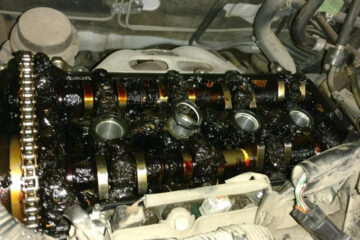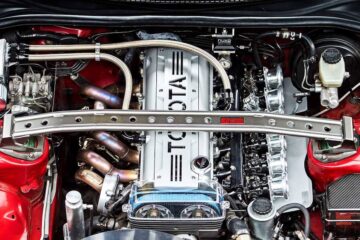Despite the global shift toward electrification, internal combustion engines (ICEs) are far from obsolete. In fact, 2025 has seen some of the most powerful production ICEs ever built — marvels of engineering focused on raw, unfiltered performance. This list explores the top 5 most powerful production ICEs in the world today, excluding hybrids or electric assist systems.
Hennessey Venom F5 – 6.6L Twin-Turbo V8, up to 2,031 hp
The Hennessey Venom F5, especially in its Evolution configuration, is the first production vehicle to surpass the 2,000 horsepower barrier using a pure gasoline engine — no hybrids, no electric motors.
Its monstrous 6.6-liter twin-turbo V8 produces up to 2,031 hp, paired with an ultra-lightweight carbon fiber body weighing around 1,330 kg. The result? An insane power-to-weight ratio and mind-blowing acceleration — 0 to 200 mph (322 km/h) in just over 10 seconds.
The Venom F5 is designed not for racetracks, but for one thing: outright top speed. It’s a raw, analog expression of American power engineering, offering unmatched performance from a conventional ICE.
SSC Tuatara – 5.9L Twin-Turbo V8, up to 1,750 hp (on ethanol)
The SSC Tuatara from the U.S. is another beast aimed at top-speed supremacy. Its 5.9L twin-turbo V8 can generate up to 1,750 hp when running on ethanol-based E85 fuel. On regular gasoline, power drops slightly to around 1,350 hp — still impressive.
The Tuatara is built for velocity, with a claimed top speed exceeding 295 mph (475+ km/h). With low weight, slick aerodynamics, and extreme engine tuning, it’s one of the fastest ICE-powered cars on the planet.
Its engine also boasts extremely high specific output (nearly 300 hp per liter), placing it among the most thermally and mechanically efficient ICEs ever produced.
Koenigsegg Jesko Absolut – 5.0L Twin-Turbo V8, 1,600 hp (on E85)
Swedish manufacturer Koenigsegg offers one of the most advanced ICEs in the world: a 5.0L twin-turbocharged V8 capable of producing 1,600 hp when running on E85 biofuel (and 1,280 hp on regular gasoline).
This engine is a technological marvel — ultra-light, compact, and incredibly responsive. The Jesko Absolut variant is designed for top-speed runs, with drag-reducing bodywork and a focus on straight-line performance. Koenigsegg claims it could eventually surpass 330 mph (531 km/h), although official tests are ongoing.
What sets the Jesko’s engine apart is its balance between brute force and engineering finesse — hitting 320 hp per liter while remaining fully road-legal and emissions-compliant.
Chevrolet Corvette ZR1 – 5.5L Twin-Turbo V8 (LT7), 1,064 hp
The 2025 Chevrolet Corvette ZR1 introduces the most powerful V8 engine General Motors has ever built: the LT7, a 5.5-liter twin-turbocharged V8 generating 1,064 hp and 828 lb-ft of torque.
This makes the ZR1 not just the fastest Corvette ever, but a legitimate contender in the hypercar segment — all from a front-mounted engine and RWD layout. The LT7 is derived from the flat-plane crank LT6 used in the Z06 but adds twin turbochargers for over 400 additional horsepower.
With a top speed over 215 mph (346 km/h), the ZR1 redefines what American sports cars can do with a traditional V8 powerplant.
Aston Martin Valkyrie – 6.5L Naturally Aspirated V12, ~1,130 hp
The only naturally aspirated engine on this list — and the most powerful N/A ICE in any production car — is the 6.5L V12 developed by Cosworth for the Aston Martin Valkyrie. It produces approximately 1,130 hp without any forced induction or electrification.
This engine revs to a staggering 11,100 rpm and delivers a Formula 1–like sound experience. Built with ultra-lightweight materials and F1-derived technology, the Valkyrie’s V12 weighs just over 200 kg and delivers razor-sharp throttle response.
It’s the last of its kind — a pure, naturally aspirated twelve-cylinder engine in an era of turbos and hybrids. That alone makes it a legend.
| Rank | Model | Engine Type | Horsepower | Notes |
|---|---|---|---|---|
| 1 | Hennessey Venom F5 (Evolution) | 6.6L Twin-Turbo V8 | 2,031 hp | Highest ICE output in a production car |
| 2 | SSC Tuatara | 5.9L Twin-Turbo V8 (E85) | 1,750 hp | Record-setting top speed potential |
| 3 | Koenigsegg Jesko Absolut | 5.0L Twin-Turbo V8 (E85) | 1,600 hp | Best power-per-liter ratio |
| 4 | Chevrolet Corvette ZR1 | 5.5L Twin-Turbo V8 (LT7) | 1,064 hp | Most powerful GM V8 ever made |
| 5 | Aston Martin Valkyrie | 6.5L Naturally Aspirated V12 | ~1,130 hp | Most powerful NA production engine |
Why These Engines Matter
1. Raw ICE Performance
These engines represent the absolute limit of what’s possible from gasoline-only propulsion. They are built for enthusiasts who still value unfiltered mechanical power and visceral sound.
2. Speed Above All
Models like the Venom F5 and Tuatara prioritize extreme velocity, pushing ICE-powered cars to speeds that rival fighter jets.
3. Engineering Mastery
Engines like the Cosworth V12 or Koenigsegg’s V8 are technical masterclasses — incredibly compact, lightweight, and powerful.
4. No Electric Assist
Each of these engines delivers full output without relying on hybrid or electric components — which is increasingly rare today.
Honorable Mentions
Bugatti W16 (Chiron, Super Sport, Bolide): Despite outputs up to 1,825 hp, the W16 was discontinued in 2024, with the final Chiron rolling off the line in May that year.
Koenigsegg Gemera (Hybrid V8): The 2025 Gemera produces a total of 2,300 hp with hybrid assistance. However, the internal combustion portion remains the same 1,600 hp V8 from the Jesko — thus not exceeding Jesko’s standalone ICE output.
Ford Megazilla Crate Engines: Some aftermarket crate engines from Ford and other manufacturers can exceed 1,000 hp, but they aren’t installed in production vehicles and therefore aren’t considered here.
Conclusion
In 2025, the most powerful internal combustion engines still push the boundaries of physics and engineering:
- Hennessey Venom F5 Evolution – 2,031 hp
- SSC Tuatara – 1,750 hp
- Koenigsegg Jesko Absolut – 1,600 hp
- Chevrolet Corvette ZR1 LT7 – 1,064 hp
- Aston Martin Valkyrie V12 – ~1,130 hp (N/A)
These are the last true giants of combustion — and perhaps the final peak of ICE engineering before full electrification. They’re loud, fast, brutally mechanical — and utterly irreplaceable.







0 Comments